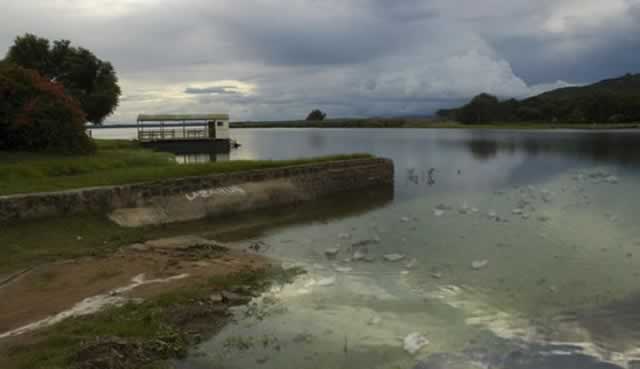Harare water woes result of climatic change


The latest water cuts have been prompted by a drying up and extremely polluted Lake Chivero, Harare’s main water source
Jeffrey Gogo Climate Story
RESURGENT water woes in Harare risk developing not only into a major public health hazard —again — but are also evidence of the existential threat posed by climate change and global warming on the water-dependent sectors of health, agriculture and energy.
As climate change-related droughts become common, Harare was last month forced cut its already inadequate amount of water pumped into households by 18 percent to 450 million litres per day, leaving thousands of people completely without safe drinking water.
Water demand tops 800 million litres each day.
The latest cuts have been prompted by a drying up and extremely polluted Lake Chivero, Harare’s main water source, says city spokesperson, Michael Chideme.
In 2008, water supply fell to as low as 300 million litres per day before labouring back to 550 million litres last year thanks to a $144 million Chinese loan for upgrading water infrastructure.
Now, with supplies to hotspot townships like Mabvuku and Hatcliffe completely disconnected, the quality of Harare’s drinking water in those areas privileged to be still receiving council services has once again come into question.
“As far as the quality of drinking water is concerned, the probability of use of unprotected and untreated water sources may increase in cases were traditional local authority services have been the norm,” said Mr Khumbulani Murenga, executive director Institute of Water and Sanitation Development (IWSD).
The World Health Organisation (WHO) recommends 20 litres as the minimum daily water needs for the individual to maintain basic hygiene, but not for the folk in Mabvuku or those in Hatcliffe who rely on shallow wells or crowded community boreholes.
With an estimated population of 2,1 million, according to the 2012 Census, Harare is technically producing 214 litres of water per day per person, but that would be celebrated if that much amount of water reached households consistently.
The city loses 57 percent of its treated water to leakages from aged pipelines that have also failed to contain the capital’s rapid population growth, which rose more than 2 percent per year in the 10 years to 2012.
Dirty water
But since 2009, the number of households with access to improved drinking water and sanitation in Harare has tumbled from 95 percent to 38,4 percent in 2014, according to the Multiple Indicator Cluster Survey (2014), stoking fears of an imminent infectious disease outbreak.
Residents complain Harare’s water is visibly dirty, often pumping out of the tap greenish/darkish in colour and smelling like dead fish, a charge city authorities deny.
“The drinking water (final product after treatment) is of high quality,” claimed council spokesperson Chideme.
“We reduced the amount of raw water that we treat for us to maintain standards. We realised that to maintain standards we had to reduce the amount to treat because of the high levels of pollution in the Lake (Chivero).”
Water must be free of traces of faecal matter such as E-coli or of any chemical sediments like arsenic to meet the WHO quality guidelines for safe drinking water. Harare’s water defaults on some of these aspects. “It is important to stress that of the two components, microbial contamination poses the biggest threat to public health and it is therefore imperative to ensure that E-coli is not detectable in drinking water,” said IWSD’s Murenga, by email.
“When in doubt, it is always prudent to conduct additional household water treatment before consumption.”
Poor, poor Harare City
Contaminated water may cause diarrhhea, typhoid and cholera, experts say. A cholera epidemic in 2008 /09 that began in Harare killed 4 000 people and affected 100 000 more countrywide.
In August last year, nearly 20 cases of typhoid fever were reported in Harare due to the unavailability of safe drinking water, according to the Health Ministry, indicating water-related diseases still remain a major threat to public health, and most ashamedly in a capital city thought to bear Zimbabwe’s light to the world.
Harare Residents Trust director, Precious Shumba, said the Harare City Council was giving residents a raw deal, claiming almost half of the city’s residents provided their own water by means possible to them.
“In our own analysis as the HRT, the City of Harare has only been able to make water available to around 55 percent of Harare residents, with the rest depending on private boreholes, shallow wells, community boreholes drilled by humanitarian agencies,” he said.
“Laundry is being done along tributaries and streams, for example, in Glen Lorne and Glen Norah C, along Mukuvisi River.”
Water has emerged as a serious short and long-term risk to industry and society, according to a recent World Economic Forum report.
It says water is now an urgent political matter that is deeply intertwined with climate change, economic stability, and human migration.
Now, with back to back droughts in the past three rain seasons since 2013, largely as a result of climate change, and lately El Nino, there is no guarantee rains collecting into Chivero will offer a lasting solution to the city’s water supply in 2016 and beyond.
And Harare’s climate change plan is just spectacular in its deficiency; its short-sightedness.
“The Harare City Council has modern facilities that we use to recycle wastewater . . . ” said Chideme, clearly awake to the inadequacy of this half-baked strategy.
In short, the city authority is devoid of a real long-term plan to address water challenges arising from harsher, warmer climates, or for taming pollution, in which it is a top player. Kunzvi dam remains a pipe dream.
And yet, the future looks hazy, blighted by increased water scarcity. In a world that is 4 degrees Celsius warmer, as is largely expected by 2080, water in the rivers, lakes and streams in countries such as Zimbabwe, the DRC, Mozambique and Sudan will decline by up to 50 percent, according to a 2012 World Bank report.
Lakes like Chivero are now at the mercy of global warming, requiring comprehensive conservation strategies.
God is faithful.









Comments